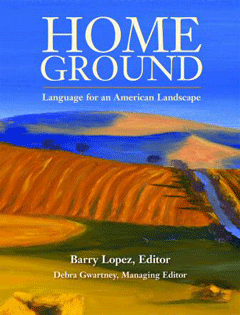Land for the Good of All
Air Date: Week of May 29, 2009

"Home Ground: Language for an American Landscape," edited by Barry Lopez and Debra Gwartney. (Courtesy of Trinity University Press)
Living on Earth continues its series exploring features of the American landscape. It’s based on the book “Home Ground: Language for an American Landscape,” edited by Barry Lopez and Debra Gwartney. In this installment, Pamela Frierson explains the term “ahupua’a.”
Transcript
GELLERMAN: One danger of climate change is that it may destroy the most cherished features of our home planet: our forests, seashores, glaciers and snow-capped mountains.
Describing the features of the landscape enriches our appreciation and understanding. Learning about the geography that surrounds us, connects us, it puts us into context, which is the goal of the book “Home Ground,” compiled by Barry Lopez and Debra Gwartney.
From time to time we take note of this miscellany of American landscape descriptions. Today Pamela Frierson has an historical term from Hawaii: ahupua‘a.
FRIERSON: Ahupua’a. The most important unit in the ancient Hawaiian system of land division was the ahupua'a, a pie-shaped wedge running from a high point on the island to the coast and some distance out to sea. Since Hawaiian Islands tend to have rain-carved valleys originating at central mountains and opening out toward the coast, an ahupua'a often roughly followed the contours of watersheds.

"Home Ground: Language for an American Landscape," edited by Barry Lopez and Debra Gwartney. (Courtesy of Trinity University Press)
The coastal boundaries were marked by an ahu, a heap of piled stones supporting a carved wooden image of a pua'a, or pig--symbol of the tribute paid annually to the paramount chief of the island by the lesser chiefs in charge of each ahupua'a. The commoners within an ahupua'a, living in extended families, held tenancy to small landholdings called 'ili. The ahupua'a provided the resources to sustain a community: access to upland forests for timber, lowlands for growing crops, and fishing and gathering along a stretch of coast. This traditional system ended in 1848 when Kamehameha III was persuaded by foreigners to institute the Great Mahele, or division, which allowed land to be bought and sold. In modern times ahupua'a holds both the traditional meaning and a broader one of environmentally responsible land use.
GELLERMAN: Writer and photographer Pamela Frierson lives on the slopes of Mauna Kea Volcano on Hawaii Island. Her definition of “ahupua‘a” comes from the book “Home Ground: Language for an American Landscape”, edited by Barry Lopez and Debra Gwartney.
Links
Living on Earth wants to hear from you!
Living on Earth
62 Calef Highway, Suite 212
Lee, NH 03861
Telephone: 617-287-4121
E-mail: comments@loe.org
Newsletter [Click here]
Donate to Living on Earth!
Living on Earth is an independent media program and relies entirely on contributions from listeners and institutions supporting public service. Please donate now to preserve an independent environmental voice.
NewsletterLiving on Earth offers a weekly delivery of the show's rundown to your mailbox. Sign up for our newsletter today!
 Sailors For The Sea: Be the change you want to sea.
Sailors For The Sea: Be the change you want to sea.
 The Grantham Foundation for the Protection of the Environment: Committed to protecting and improving the health of the global environment.
The Grantham Foundation for the Protection of the Environment: Committed to protecting and improving the health of the global environment.
 Contribute to Living on Earth and receive, as our gift to you, an archival print of one of Mark Seth Lender's extraordinary wildlife photographs. Follow the link to see Mark's current collection of photographs.
Contribute to Living on Earth and receive, as our gift to you, an archival print of one of Mark Seth Lender's extraordinary wildlife photographs. Follow the link to see Mark's current collection of photographs.
 Buy a signed copy of Mark Seth Lender's book Smeagull the Seagull & support Living on Earth
Buy a signed copy of Mark Seth Lender's book Smeagull the Seagull & support Living on Earth

